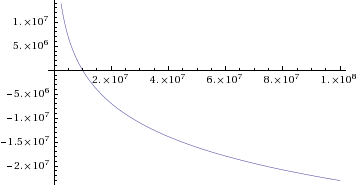
Napierian logarithm
Encyclopedia
The term Napierian logarithm, or Naperian logarithm, is often used to mean the natural logarithm
. However, as first defined by John Napier
, it is a function given by (in terms of the modern logarithm
):

(Since this is a quotient of logarithms, the base of the logarithm chosen is irrelevant.)
It is not a logarithm to any particular base in the modern sense of the term; however, it can be rewritten as:
and hence it is a linear function of a particular logarithm, and so satisfies identities quite similar to the modern one.
The Napierian logarithm is related to the natural logarithm
by the relation
and to the common logarithm
by
Natural logarithm
The natural logarithm is the logarithm to the base e, where e is an irrational and transcendental constant approximately equal to 2.718281828...
. However, as first defined by John Napier
John Napier
John Napier of Merchiston – also signed as Neper, Nepair – named Marvellous Merchiston, was a Scottish mathematician, physicist, astronomer & astrologer, and also the 8th Laird of Merchistoun. He was the son of Sir Archibald Napier of Merchiston. John Napier is most renowned as the discoverer...
, it is a function given by (in terms of the modern logarithm
Logarithm
The logarithm of a number is the exponent by which another fixed value, the base, has to be raised to produce that number. For example, the logarithm of 1000 to base 10 is 3, because 1000 is 10 to the power 3: More generally, if x = by, then y is the logarithm of x to base b, and is written...
):

(Since this is a quotient of logarithms, the base of the logarithm chosen is irrelevant.)
It is not a logarithm to any particular base in the modern sense of the term; however, it can be rewritten as:
and hence it is a linear function of a particular logarithm, and so satisfies identities quite similar to the modern one.
The Napierian logarithm is related to the natural logarithm
Natural logarithm
The natural logarithm is the logarithm to the base e, where e is an irrational and transcendental constant approximately equal to 2.718281828...
by the relation
and to the common logarithm
Common logarithm
The common logarithm is the logarithm with base 10. It is also known as the decadic logarithm, named after its base. It is indicated by log10, or sometimes Log with a capital L...
by





